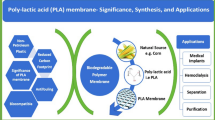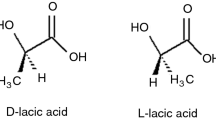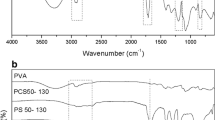Abstract
A novel branched polyether is prepared with 1,1,2,2-tetrakis (4-hydroxyphenyl) ethane as a core, amino groups as backbone, and polypropylene oxide (PPO)–polyethylene oxide (PEO) chains as branches based on phenol-amine resin, propylene oxide (PO), and ethylene oxide (EO). The surface activity is investigated by surface tension measurement at different temperature. The increase in PO/EO ratio or PPO chain lengths improve the surface activity and decrease the critical micelle concentration (cmc) as well as increase the temperature. The addition of inorganic salts causes a slight increase in cmc. The demulsification of water-in-crude-oil (W/O) emulsions, whether from polymer flooding or not, shows that the branched polyether is a good demulsifier to break the W/O emulsions. The stability of W/O emulsion in the presence of polyether shows that the highest water dehydration is not necessarily the highest stability index of W/O emulsion due to the turbidity of separated water. The demulsification process is also observed by microscope. Distribution of the polyether after demulsification is evaluated by partition coefficient at various concentrations.















Similar content being viewed by others
References
Nguyen D, Balsamo V, Phan J (2014) Effect of diluents and asphaltenes on interfacial properties and steam-assisted gravity drainage emulsion stability: interfacial rheology and wettability. Energy Fuels 28:1641–1651
Perino A, Noïk C, Dalmazzone C (2013) Effect of fumed silica particles on water-in-crude oil emulsion: emulsion stability, interfacial properties, and contribution of crude oil fractions. Energy Fuels 27:2399–2412
Kralova I, Sjöblom J, Øye G, Simon S, Grimes BA, Paso K (2011) Heavy crude oils/particle stabilized emulsions. Adv Colloid Interface Sci 169:106–127
Deng S, Yu G, Jiang Z, Zhang R, Ting YP (2005) Destabilization of oil droplets in produced water from ASP flooding. Colloids Surf, A 252:113–119
Wu X (2002) Investigating the stability mechanism of water-in-diluted bitumen emulsions through isolation and characterization of the stabilizing materials at the interface. Energy Fuels 17:179–190
Gao C, Shi J, Zhao F (2014) Successful polymer flooding and surfactant-polymer flooding projects at Shengli Oilfield from 1992 to 2012. J Petrol Explor Prod Technol 4:1–8
Jung JC, Zhang K, Chon BH, Choi HJ (2013) Rheology and polymer flooding characteristics of partially hydrolyzed polyacrylamide for enhanced heavy oil recovery. J Appl Polym Sci 127:4833–4839
Yang Q, Xin X, Wang L, Lu H, Ren H, Tan Y, Xu G (2014) Modification of the stability of oil-in-water nano-emulsions by polymers with different structures. Colloid Polym Sci 292:1297–1306
Qiu J (2013) Stability of the oil–water emulsion formed during amphiphilic polymer flooding. J Pet Sci Technol 31:142–147
Qu G, Gong X, Liu Y (2014) New research progress of the demulsification of produced liquid by polymer flooding. J Chem Pharm Res 6:634–640
Xie Y, Yan F, Yan Z, Zhang J, Li J (2012) Demulsification and interfacial properties of crosslinking phenol-amine resin block polyether demulsifiers. J Dispersion Sci Technol 33:1674–1681
Xu Y, Wu J, Dabros T, Hamza H, Venter J (2005) Optimizing the polyethylene oxide and polypropylene oxide contents in diethylenetriamine-based surfactants for destabilization of a water-in-oil emulsion. Energy Fuels 19:916–921
Kailey I, Feng X (2013) Influence of structural variations of demulsifiers on their performance. Ind Eng Chem Res 52:785–793
Cooper DG, Zajic JE, Cannel EJ, Wood JW (1980) The relevance of “HLB” to de-emulsification of a mixture of heavy oil, water and clay. Can J Chem Eng 58:576–579
Zaki NN, Abdel-Raouf ME, Abdel-Azim AAA (1996) Propylene oxide-ethylene oxide block copolymers as demulsifiers for water-in-oil emulsions. I. Effect of molecular weight and hydrophilic-lipophilic balance on the demulsification efficiency. Monatsh Chem 127:621–629
Fan Y, Simon SB, Sjöblom J (2009) Chemical destabilization of crude oil emulsions: effect of nonionic surfactants as emulsion inhibitors. Energy Fuels 23:4575–4583
Atta AM, Fadda AA, Abdel-Rahman AAH, Ismail HS, Fouad RR (2012) Application of new modified poly(ethylene oxide)-block-poly(propylene oxide)-block-poly(ethylene oxide) copolymers as demulsifier for petroleum crude oil emulsion. J Dispersion Sci Technol 33:775–785
Wu J, Xu Y, Dabros T, Hamza H (2005) Effect of EO and PO positions in nonionic surfactants on surfactant properties and demulsification performance. Colloids Surf, A 252:79–85
Daniel-David D, Pezron I, Dalmazzone C, Noïk C, Clausse D, Komunjer L (2005) Elastic properties of crude oil/water interface in presence of polymeric emulsion breakers. Colloids Surf, A 270–271:257–262
Staiss F, Boehm R, Kupfer R (1991) Improved demulsifier chemistry. A novel approach in the dehydration of crude oil. SPE Prod Eng 6:334–334
A Abdel-Azim A-A, Zaki NN, Maysour NES (1998) Polyoxyalkylenated amines for breaking water-in-oil emulsions: effect of structural variations on the demulsification efficiency. Polym Adv Technol 9:159–166
Rosen M (1972) The relationship of structure to properties in surfactants. J Am Oil Chem Soc 49:293–297
Zhang Z, Xu G, Wang F, Dong S, Chen Y (2005) Demulsification by amphiphilic dendrimer copolymers. J Colloid Interface Sci 282:1–4
Al-Sabagh AM, Kandile NG, Noor El-Din MR (2011) Functions of demulsifiers in the petroleum industry. Sep Sci Technol 46:1144–1163
Zaki NN, Abdel-Raouf ME, Abdel-Azim A-AA (1996) Polyoxyethylenated bisphenol-A for breaking water-in-oil emulsions. Polym Adv Technol 7:805–808
Zhang Z, Xu GY, Wang F, Dong SL, Li YM (2004) Characterization and demulsification of poly(ethylene oxide)-block-poly(propylene oxide)-block-poly(ethylene oxide) copolymers. J Colloid Interface Sci 277:464–470
Al-Sabagh AM, Noor El-Din MR, Morsi RE, Elsabee MZ (2008) Demulsification efficiency of some novel styrene/maleic anhydride ester copolymers. J Appl Polym Sci 108:2301–2311
Li Simon MK (1991) Process for preparing tetraphenolic compounds. US Patent 5,012,016, 30 Apr 1991
Zhai X, Xu G, Chen Y, Liu T, Zhang J, Yuan J, Tan Y, Zhang J (2013) Effect of inorganic salts on the aggregation behavior of branched block polyether at air/water and n-heptane/water interfaces. Colloid Polym Sci 291:2825–2836
Gong H, Xu G, Ding H, Shi X, Tan Y (2009) Aggregation behavior of block polyethers with branched structure at air/water surface. Eur Polym J 45:2540–2548
Kositza MJ, Bohne C, Alexandridis P, Hatton TA, Holzwarth JF (1999) Micellization dynamics and impurity solubilization of the block-copolymer L64 in an aqueous solution. Langmuir 15:322–325
Nordon A, Meunier C, Carr RH, Gemperline PJ, Littlejohn D (2002) Determination of the ethylene oxide content of polyether polyols by low-field 1H nuclear magnetic resonance spectrometry. Anal Chim Acta 472:133–140
Sanan R, Mahajan RK (2013) Polyethylene glycol assisted micellar, interfacial and phase separation studies of triblock copolymer–nonionic surfactant mixtures. Colloids Surf, A 433:145–153
Rub MA, Asiri AM, Azum N, Khan A, Khan AAP, Khan SB, Rahman MM, Kabir ud D (2013) Aggregation and phase separation behavior of an amphiphilic drug promazine hydrochloride under the influence of inorganic salts and ureas. Thermochim Acta 574:26–37
Varade D, Sharma R, Aswal VK, Goyal PS, Bahadur P (2004) Effect of hydrotropes on the solution behavior of PEO/PPO/PEO block copolymer L62 in aqueous solutions. Eur Polym J 40:2457–2464
Patel T, Bahadur P, Mata J (2010) The clouding behaviour of PEO–PPO based triblock copolymers in aqueous ionic surfactant solutions: a new approach for cloud point measurements. J Colloid Interface Sci 345:346–350
JM Barad, M Chakraborty, H-J r Bart (2010) Stability and performance study of water-in-oil-in-water emulsion: extraction of aromatic amines. Ind. Eng. Chem. Res 49:5808–5815
Kang W, Xu B, Wang Y, Li Y, Shan X, An F, Liu J (2011) Stability mechanism of W/O crude oil emulsion stabilized by polymer and surfactant. Colloids Surf, A 384:555–560
Kaombe DD, Lenes M, Toven K, Glomm WR (2013) Turbiscan as a tool for studying the phase separation tendency of pyrolysis oil. Energy Fuels 27:1446–1452
Xu B, Kang W, Meng L, Yang R, Liu S, Zhang L (2013) Synthesis, aggregation behavior and emulsification characteristic of a multi-sticker amphiphilic polymer. J Macromol Sci A 50:302–309
Bai Y, Xiong C, Shang X, Xin Y (2014) Experimental study on ethanolamine/surfactant flooding for enhanced oil recovery. Energy Fuels 28:1829–1837
Dudášová D, Sjöblom J, Øye G (2014) Characterization and suspension stability of particles recovered from offshore produced water. Ind Eng Chem Res 53:1431–1436
Li P-w, Yang D-j, Lou H-m, Qiu X-q (2008) Study on the stability of coal water slurry using dispersion-stability analyzer. J Fuel Chem Technol 36:524–529
Ravera F, Ferrari M, Liggieri L, Miller R, Passerone A (1997) Measurement of the partition coefficient of surfactants in water/oil systems. Langmuir 13:4817–4820
Bennett B, Aplin AC, Larter SR (2003) Measurement of partition coefficients of phenol and cresols in gas-charged crude oil/water systems. Org Geochem 34:1581–1590
Deyerle BA, Zhang Y (2011) Effects of Hofmeister anions on the aggregation behavior of PEO–PPO–PEO triblock copolymers. Langmuir 27:9203–9210
Schott H (1969) Hydrophile-lipophile balance and cloud points of nonionic surfactants. J Pharm Sci 58:1443–1449
Sayed GH, Ghuiba FM, Abdou MI, Badr EAA, Tawfik SM, Negm NAM (2012) Synthesis, surface, thermodynamic properties of some biodegradable vanillin-modified polyoxyethylene surfactants. J Surfact Deterg 15:735–743
Wang J, Li C-Q, An N, Yang Y (2012) Synthesis and demulsification of two lower generation hyperbranched polyether surfactants. Sep Sci Technol 47:1583–1589
Dong J, Chowdhry BZ, Leharne SA (2003) Surface activity of poloxamines at the interfaces between air–water and hexane–water. Colloids Surf, A 212:9–17
Alexandridis P, Athanassiou V, Fukuda S, Hatton TA (1994) Surface activity of poly(ethylene oxide)-block-poly(propylene oxide)-block-poly(ethylene oxide) copolymers. Langmuir 10:2604–2612
Xin X, Xu G, Zhang Z, Chen Y, Wang F (2007) Aggregation behavior of star-like PEO–PPO–PEO block copolymer in aqueous solution. Eur Polym J 43:3106–3111
Couderc S, Li Y, Bloor DM, Holzwarth JF, Wyn-Jones E (2001) Interaction between the nonionic surfactant hexaethylene glycol mono-n-dodecyl ether (C12EO6) and the surface active nonionic ABA block copolymer pluronic F127 (EO97PO69EO97)—formation of mixed micelles studied using isothermal titration calorimetry and differential scanning calorimetry. Langmuir 17:4818–4824
Rosen M (1974) Relationship of structure to properties in surfactants: II. Efficiency in surface or interfacial tension reduction. J Am Oil Chem Soc 51:461–465
Rosen MJ, Aronson S (1981) Standard free energies of adsorption of surfactants at the aqueous solution/air interface from surface tension data in the vicinity of the critical micelle concentration. Colloids and Surfaces 3:201–208
Rosen MJ, Cohen AW, Dahanayake M, Hua XY (1982) Relationship of structure to properties in surfactants. 10. Surface and thermodynamic properties of 2-dodecyloxypoly(ethenoxyethanol)s, C12H25(OC2H4)xOH, in aqueous solution. J Phys Chem 86:541–545
Kwan C-C, Rosen MJ (1978) The relationship of structure to properties in surfactants: VII. Synthesis and properties of some sodium 1,4-and 2,6-alkoxynaphthalenesulfonates. J Am Oil Chem Soc 55:625–628
Al Sabagh AM, Kandil NG, Badawi AM, El-Sharkawy H (2000) Surface activity and thermodynamic of micellization and adsorption for isooctylphenol ethoxylates, phosphate esters and their mixtures with N-diethoxylated perfluorooctanamide. Colloids Surf, A 170:127–136
Dahanayake M, Cohen AW, Rosen MJ (1986) Relationship of structure to properties of surfactants. 13. Surface and thermodynamic properties of some oxyethylenated sulfates and sulfonates. J Phys Chem B 90:2413–2418
Islam MN, Kato T (2005) Effect of temperature on the surface phase behavior and micelle formation of a mixed system of nonionic/anionic surfactants. J Colloid Interface Sci 282:142–148
Patel K, Bahadur P, Guo C, Ma JH, Liu HZ, Yamashita Y, Khanal A, Nakashima K (2007) Salt induced micellization of very hydrophilic PEO–PPO–PEO block copolymers in aqueous solutions. Eur Polym J 43:1699–1708
Sadeghi R, Jahani F (2012) Salting-in and salting-out of water-soluble polymers in aqueous salt solutions. J Phys Chem B 116:5234–5241
Bahadur P, Pandya K, Almgren M, Li P, Stilbs P (1993) Effect of inorganic salts on the micellar behaviour of ethylene oxide-propylene oxide block copolymers in aqueous solution. Colloid Polym Sci 271:657–667
Jolicoeur C, Philip PR (1974) Enthalpy–entropy compensation for micellization and other hydrophobic interactions in aqueous solutions. Can J Chem Eng 52:1834–1839
Chen L-J, Lin S-Y, Huang C-C, Chen E-M (1998) Temperature dependence of critical micelle concentration of polyoxyethylenated non-ionic surfactants. Colloids Surf, A 135:175–181
Islam MN, Kato T (2003) Temperature dependence of the surface phase behavior and micelle formation of some nonionic surfactants. J Phys Chem B 107:965–971
Chen Y, Liu T, Xu G, Zhang J, Zhai X, Yuan J, Tan Y (2015) Aggregation behavior of X-shaped branched block copolymers at the air/water interface: effect of block sequence and temperature. Colloid Polym Sci 293:97–107
Sugihara G, Hisatomi M (1999) Enthalpy–entropy compensation phenomenon observed for different surfactants in aqueous solution. J Colloid Interface Sci 219:31–36
Hsu Y-H, Tsui H-W, Lee C-F, Chen S-H, Chen L-J (2015) Effect of alcohols on the heat of micellization of Pluronic F88 aqueous solutions. Colloid Polym Sci 293:3403–3415
Tsui H-W, Hsu Y-H, Wang J-H, Chen L-J (2008) Novel behavior of heat of micellization of Pluronics F68 and F88 in aqueous solutions. Langmuir 24:13858–13862
Ge X, Yang J, Xu X, Gao J (2010) The demulsification of crude emulsion of ASP flooding by an organic silicone demulsifier. J Pet Sci Technol 28:1013–1024
Atta AM, Ismail HS, Elsaeed AM, Fouad RR, Fada AA, Abdel-Rahman AAH (2013) Preparation and application of nonionic polypropylene oxide-graft-polyethylene glycol copolymer surfactants as demulsifier for petroleum crude oil emulsions. J Dispersion Sci Technol 34:161–172
Wen Y, Cheng H, Lu L-J, Liu J, Feng Y, Guan W, Zhou Q, Huang X-F (2010) Analysis of biological demulsification process of water-in-oil emulsion by Alcaligenes sp. S-XJ-1. Bioresour Technol 101:8315–8322
Bennett B, Larter SR (1997) Partition behaviour of alkylphenols in crude oil/brine systems under subsurface conditions. Geochim Cosmochim Acta 61:4393–4402
Hernandez EI, Castro-Sotelo LV, Avendano-Gomez JR, Flores CA, Alvarez-Ramirez F, Vazquez F (2016) Synthesis, characterization, and evaluation of petroleum demulsifiers of multibranched block copolymers. Energy Fuels 30:5363–5378
Zhang P, Wang H, Liu X, Shi X, Zhang J, Yang G, Sun K, Wang J (2014) The dynamic interfacial adsorption and demulsification behaviors of novel amphiphilic dendrimers. Colloids Surf, A 443:473–480
Wang J, Li CQ, Li J, Yang JZ (2007) Demulsification of crude oil emulsion using polyamidoamine dendrimers. Sep Sci Technol 42:2111–2120
Filali M, Aznar R, Svenson M, Porte G, Appell J (1999) Swollen micelles plus hydrophobically modified hydrosoluble polymers in aqueous solutions: decoration versus bridging. A small angle neutron scattering study. J Phys Chem B 103:7293–7301
Maccarrone S, Allgaier J, Frielinghaus H, Richter D (2014) Anchoring vs bridging: new findings on polymer additives in bicontinuous microemulsions. Langmuir 30:1500–1505
Acknowledgments
The authors gratefully acknowledge the financial support from Major Research of Science and Technology, China (grant no. 2016ZX05025-003-02).
Author information
Authors and Affiliations
Corresponding author
Ethics declarations
Conflict of interest
The authors declare that they have no competing interests.
Rights and permissions
About this article
Cite this article
Li, Z., Yin, S., Tan, G. et al. Synthesis and properties of novel branched polyether as demulsifiers for polymer flooding. Colloid Polym Sci 294, 1943–1958 (2016). https://doi.org/10.1007/s00396-016-3956-x
Received:
Revised:
Accepted:
Published:
Issue Date:
DOI: https://doi.org/10.1007/s00396-016-3956-x




